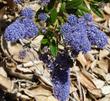Ceanothus 'Joyce Coulter'
Creeping Mountain Lilac.
Joyce Coulter blooms medium blue in March-May, has dark green foliage, and is heat and drought tolerant.
One of the more reliable ground covers that deer bother only in bad years with high deer populations. The deer ate the bark off of the Blue oaks before they'd eat Joyce Coulter...
We observed no damage to watered container stock at 8 degrees F. and they were frozen solid for 4 days. In dry soil about 110-12F knocked them out. Zero Fahrenheit does seem to be too cold in moist ground. Our garden specimen froze at 0 degrees F., but recovered nicely at somewhere between 4-7 degrees F. It seems how hydrated the soil and plant are can make a huge difference on its cold tolerance.
The only 'problem' we've had with it is it will sometimes grow up instead of horizontal. If you want a ground cover from this, be cognizant of this and tip prune the upright stems.
Ceanothus 'Joyce Coulter' is believed to be a hybrid between Ceanothus papillosus var. roweanus and Ceanothus griseus. This ceanothus was developed in 1956 (not named until 1962)by John Coulter and named after his wife. Joyce Coulter' is very drought resistant and can live for decades in an unwatered garden, but looks at its best if the foliage is washed off every week or two. A lilac that should be in California gardens, native or otherwise; a good garden plant. Click here for more about Mountain Lilacs.
Ceanothus 'Joyce Coulter' tolerates sand and clay.
Foliage of Ceanothus 'Joyce Coulter' has color green and is evergreen.
Flower of Ceanothus 'Joyce Coulter' has color blue.
Communities for Ceanothus 'Joyce Coulter':Chaparral, Coastal Sage Scrub and Mixed-evergreen Forest.
| ph: | 5.00 to 7.70 |
|---|---|
| usda: | 8 to 10 |
| height[m]: | 0.50 to 1.00 |
| width[m]: | 1.00 to 3.00 |
| rainfall[cm]: | 40.00 to 180.00 |






 play movie
play movie


